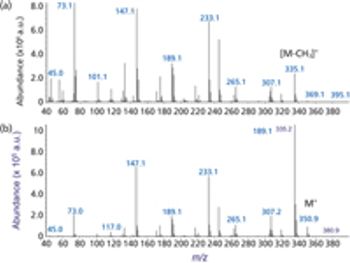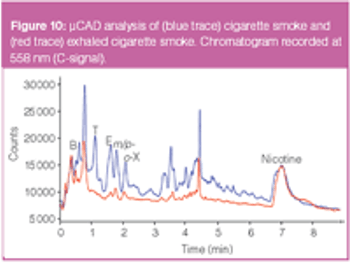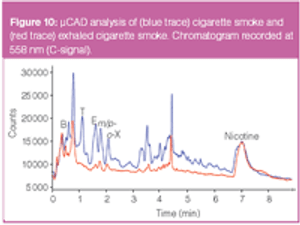
The application of gas chromatography (GC) combined with atmospheric pressure chemical ionization mass spectrometry (GC–APCI-MS) and with supersonic molecular beam ionization mass spectrometry (GC–SMB-MS).

The application of gas chromatography (GC) combined with atmospheric pressure chemical ionization mass spectrometry (GC–APCI-MS) and with supersonic molecular beam ionization mass spectrometry (GC–SMB-MS).

Soft ionization MS using GC–APCI-MS and GC–SMB-MS offers complementary identification power for the characterization of natural products, as illustrated by the identification of alkanes, sterols, long chain alcohols, and derivatized polar compounds in tobacco leaf extracts described here.

Discussing the latest developments in sample preparation techniques that reduce environmental impact.

A miniature gas chromatograph incorporating a miniaturized chemical trap for enrichment, rapid thermal desorption of the trap, a resistively heated capillary column for programmed GC analysis and a micro-chip-based plasma emission detector (PED) is described. The sampling and chromatographic conditions for the analysis of volatile compounds in air are presented. The performance of the µCAD is illustrated in the universal (carbon) mode and for the selective detection of chlorinated and organo-mercury compounds. Detection limits (DLs) are at the sub-μg/L level in the carbon mode and 10 ng/L for organo-mercury compounds.

An overview is presented of possible pathways to enhance peak capacity in liquid chromatography (LC). The peak capacity in a chromatographic separation is directly related to the plate number and thus to column length and particle size. Serial coupled columns can be used to obtain long effective column lengths, reaching over 100000 theoretical plates and peak capacities up to 900. Some theoretical considerations are made on column dimensions and particle size and examples are given of high resolution "GC-like" separations in LC using state-of-the-art LC hardware. Recent developments in LC hardware have also enhanced the applicability of two-dimensional LC–LC and comprehensive LCÃ-LC. Both techniques are extremely powerful to unravel complex samples.

This column describes the principles of stir-bar sorptive extraction and presents some typical applications.

Published: October 1st 2013 | Updated:

Published: May 1st 2013 | Updated:

Published: March 1st 2011 | Updated:

Published: March 1st 2009 | Updated:

Published: March 1st 2007 | Updated:

Published: February 1st 2003 | Updated: